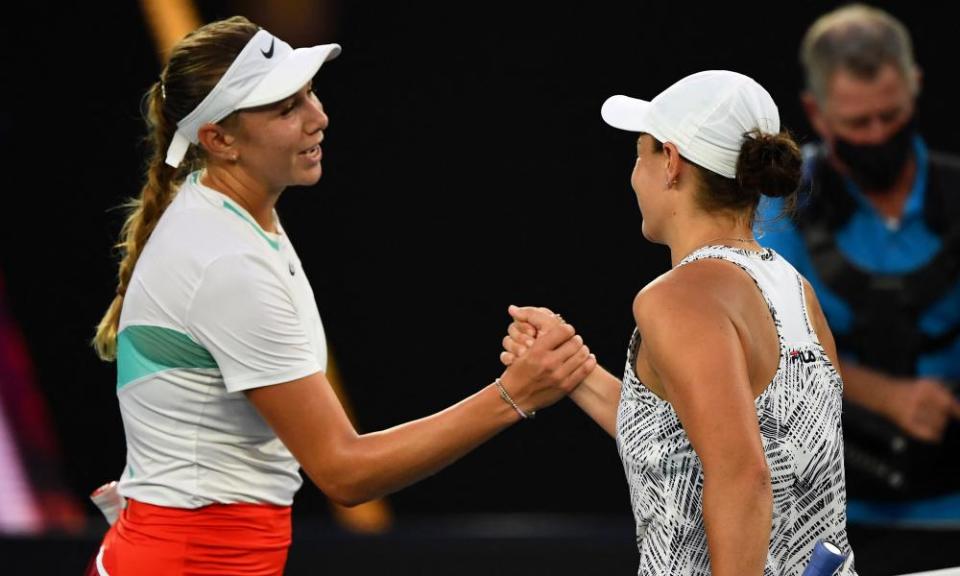Ash Barty turns on style to end Amanda Anisimova’s Australian Open revival

When Amanda Anisimova was 16 she was touted as the next Maria Sharapova, partly for her marketability but also for her pacy groundstrokes. More recently, Serena Williams’ coach, Patrick Mouratoglou, likened her to Lindsay Davenport for her impeccable timing.
Sunday night was in some ways an exhibition of both, and against other opponents that might have been enough. Two days ago, against Naomi Osaka, it was. This time, though, while Anisimova became the first player at this year’s Australian Open to break Ash Barty’s serve, she merely won the battle and not the war.
The scorecard read 6-4, 6-3 to Barty, an apt summation of a match in which the unseeded American demonstrated her increasing grand-slam clout but was well beaten by a world No 1 who, based on her form across the opening four rounds, appears on the right path to claiming her country’s first home major title in 44 years.
Last week Rod Laver called Barty “unbeatable” at her best. Anisimova did her utmost to prove him wrong. Until now no one had pushed her past the one-hour mark in a match; the 20-year-old lasted one hour and 14 minutes. She ended the Australian’s tournament serving streak of 63 straight holds to lead 2-0 in the second set, and in all provided the first real test of her first-seed credentials.
But Barty broke her straight back, then set about winning five of the remaining six games to close out the match. And where Anisimova’s offensive-mindedness got her part the way there, her inability to neutralise Barty’s sheer range had her on the back foot for much of the contest.
“She’s an incredible athlete, an incredible competitor,” Barty said of her beaten opponent. “One of her best attributes is she turns up point after point after point. It’s just nice to see her back playing her best tennis. She’s a champion. She’s going to be in a lot of deep stages of a lot of majors in her future, that’s for sure.
“I enjoy sharing the court, testing my game against her – she has an incredible game. It was nice to be able to hold firm and bring the points back into my patterns more regularly, and the big ones when it mattered most.”

They were sincere words from a player at the top of the sport about one who is fast heading back in that direction following a heavily disrupted two years. Anisimova was 17 and already a junior US Open champion when she rattled Barty in the 2019 Roland Garros semi-final, leading by a set and three games before the Australian turned the tables en route to the title.
The abrupt death of her father and coach, Konstantin, shortly thereafter put her tennis on pause, and her career-high ranking of 21 has since slipped to 60. The recent revival has coincided with coaching from Darren Cahill on a trial basis, which bore fruit this year when Anisimova won her second WTA title at the Melbourne Summer Set warm-up event.
Even so, Barty is the more vastly improved since that French Open final. She changed up her shots at will and yielded an incredible return on a serve that topped out at 182km/h. At 3-3 in the first set she had Anisimova scooting between the tramlines like she was doing a beep test and earned three break points for her troubles.
Related: Tennis Australia defends banning ‘Where is Peng Shuai?’ T-shirts at Australian Open
The 25-year-old will play her fourth consecutive Australian Open quarter-final on Tuesday against another American – 21st seed Jessica Pegula, who beat Greek fifth seed Maria Sakkari in straight sets on Sunday – with a view to becoming the first local to win the tournament since Chris O’Neil in 1978.
“She’s able to hold baseline really well,” Barty said of Pegula. “Her swings are quite linear and she gets a racket behind the ball and swings through the path. The ball comes at you at a different trajectory, and her ability to absorb pace and then add to it when she wants to is exceptional.
“It’s going to be a challenge for me to try and push her off that baseline and make her uncomfortable and feel like she has to create. But I know that she’s also going to be doing the exact same thing to me and trying to make me uncomfortable. That’s the chess game that we play. You go out there and have fun with it, see who can execute better on the day, and that’s about all there is to it.”

 Yahoo Sport
Yahoo Sport 





































